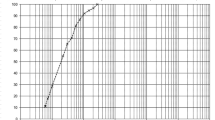Abstract
Investigation on the thermal conductivity of newspaper sandwiched Soil-based Aerated Lightweight Concrete (SALC) panels is the main purpose of this study. Control and newspaper sandwiched SALC panels of different densities (1100, 1500 and 1700 kg/m3) were produced and tested. The areal intensity of newspaper sandwiched was varied from 0.05, 0.10 to 0.15 g/cm2. The current investigation was limited to the effects of areal intensity of newspaper sandwiched and density of SALC on thermal conductivity. The results showed that the thermal conductivity of newspaper sandwiched SALC panels reduced remarkably compared to nonnewspaper sandwiched SALC panels. The percent reductions were 19.7%, 10.5% and 33.5% correspond to densities 1700, 1500 and 1100 kg/m3 with a mere areal intensity of 0.05 g/cm2 newspaper sandwiched.
Similar content being viewed by others
References
Adam, E. A. and Jones, P. J. (1995). “Thermophysical properties of stabilized soil building blocks.” Building and Environment, Vol. 30, No. 2, pp. 245–253.
ASTM C129-85 (1990). Standard specification for non-load bearing concrete masonry units, American Society of Testing Materials, West Conshohocken, Pennsylvania, USA.
ASTM C150-02a (2002). Standard specification for portland cement, American Society of Testing Materials, West Conshohocken.
Battacherjee, B. and Krishnamoorthy, S. (2004). “Permeable porosity and thermal conductivity of construction materials.” Journal of Materials in Civil Engineering, Vol.16, No. 4, pp. 322–330.
Blanco, F., Garcia, P., Mateos, P. and Ayala, J., (2000). “Characteristics and properties of lightweight concrete manufactured with cenopheres.” Cement and Concrete Research, Vol. 30, No. 11, pp. 1715–1722.
Bouguerra, A., Ledhem, A., De Barquin, F., Dheilly, R. M., and Queneudec, M. (1998). “Effect of microstructure on the mechanical and thermal properties of lightweight concrete prepared from clay, cement and wood aggregate.” Cement and Concrete Research, Vol. 28, No. 8, pp. 1179–1190.
BSEN 12664 (2001). Thermal performance of building materials and products — Determination of thermal resistance by means of guarded hot plate and heat flow meter methods — Dry and moist products of medium and low thermal resistance, British Standard Institution, London.
Budaiwi, I., Abdou, A., and Al-Homoud, M. (2002). “Variations of thermal conductivity of insulation materials under different operating temperatures: Impact on envelope-induced cooling load.” Journal of Architectural Engineering, Vol. 8, No. 4, pp. 125–132.
Demirboğa, R. (2003a). “Influence of mineral admixtures on thermal conductivity and compressive strength of mortar.” Energy and Buildings, Vol. 35, No. 2, pp. 189–192.
Demirboğa, R. (2003b). “Thermo-mechanical properties of sand and high volume mineral admixtures.” Energy and Buildings, Vol. 35, No. 5, pp. 435–439.
Demirboğa, R. and Gul, R. (2003). “Thermal conductivity and compressive strength of expanded perlite aggregate concrete with mineral admixtures.” Energy and Buildings, Vol. 35, No. 11, pp. 1155–1159.
Elfordy, S., Lucas, F., Tancret, F., Scudeller, Y., and Goudet, L. (2008). “Mechanical and thermal properties of lime and hemp concrete (“hemcrete”) manufactured by a projection process.” Construction and Building Materials, Vol. 22, No. 10, pp. 2116–2123.
EN 197-1 (2008). Cement composition, specifications and conformity criteria for common cements, Austrian Standards Institute, Heinestraβe, Wien.
Glenn, G. M., Gray, G. M., Orts, W. J., and Wood, D. W. (1999). “Starchbased lightweight concrete: Effect of starch source, processing method and aggregate geometry.” Industrial Crops and Products, Vol, 9, No. 2, pp. 133–144.
Hair, J. F., Anderson, R. E., Tatham, R. L., and Black, W. C. (1998). Mulitvariate data analysis, 5th Edn., Prentice Hall, New Jersey.
Incropera, F. P., Dewitt, D. P., Bergman, T. L., and Lavine, A. S. (2007). Introduction to heat transfer, 5th Edn., John Wiley and Sons, New Jersey.
Khedari, J., Suttisonk, B., Pratinthong, N., and Hirunlabh, J. (2001). “New lightweight composite construction materials with low thermal conductivity.” Cement and Concrete Composites, Vol. 23, No. 1, pp. 65–70.
Khedari, J., Watsanasathaporn, P., and Hirunlabh, J. (2005). “Development of fibre-based soil-cement block with low thermal conductivity.” Cement and Concrete Composites, Vol. 27, No. 1, pp. 111–116.
Kim, K. H., Jeon, S. E., Kim, J. K., and Yang, S. (2003). “An experimental study on thermal conductivity of concrete.” Cement and Concrete Research, Vol. 33, No. 3, pp. 363–371.
Kılıç, A., Atis, C. D., Yaşar, E., and Özcan. (2003). “High-strength lightweight concrete made with scoria aggregate containing mineral admixtures.” Cement and Concrete Research, Vol. 33, No. 10, pp. 1595–1599.
Ma, Y., Zhu, B., Tan, M., and Wu, K. (2004). “Effect of Y type polypropylene fiber on plastic shrinkage cracking of cement mortar.” Materials and Structures, Vol. 37, No. 2, pp. 92–95.
Mahlia, T. M. I., Taufiq, B. N., Ismail. and Masjuki, H. H. (2007). “Correlation between thermal conductivity and the thickness of selected insulation materials for building wall.” Energy and Buildings, Vol. 39, No. 2, pp. 182–187.
Ng, S. C., Low, K. S., and Tioh, N. H. (2012). “Potential use of clayey soil in aerated lightweight concrete.” KSCE Journal of Civil Engineering, KSCE, Vol. 16, No. 5, pp. 809–815.
Sukontasukkul, P. (2009). “Use of crumb rubber to improve thermal and sound properties of pre-cast concrete panel.” Construction and Building Materials, Vol. 23, No. 2, pp. 1084–1092.
Author information
Authors and Affiliations
Corresponding author
Rights and permissions
About this article
Cite this article
Low, KS., Ng, SC. & Tioh, NH. Thermal conductivity of soil-based aerated lightweight concrete. KSCE J Civ Eng 18, 220–225 (2014). https://doi.org/10.1007/s12205-014-0022-4
Received:
Revised:
Accepted:
Published:
Issue Date:
DOI: https://doi.org/10.1007/s12205-014-0022-4




